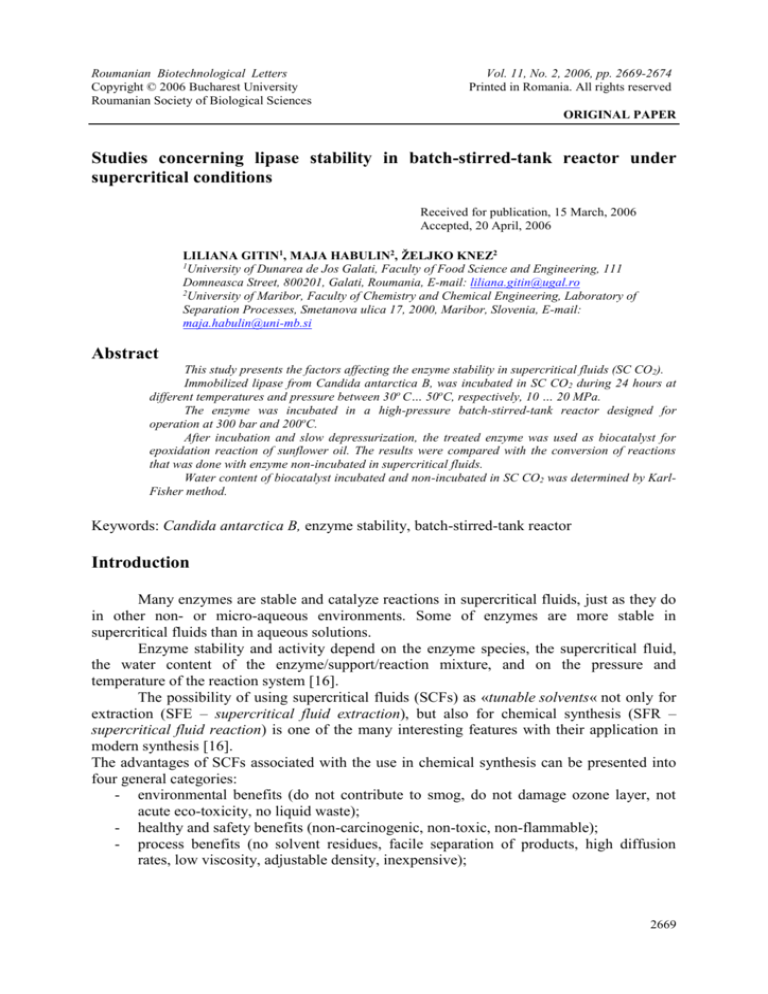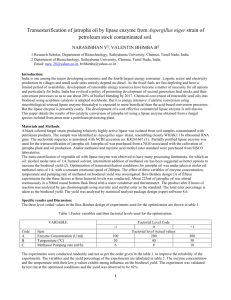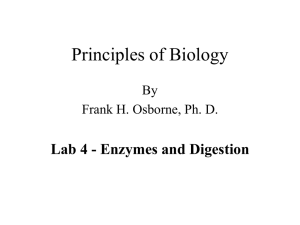
Roumanian Biotechnological Letters
Copyright © 2006 Bucharest University
Roumanian Society of Biological Sciences
Vol. 11, No. 2, 2006, pp. 2669-2674
Printed in Romania. All rights reserved
ORIGINAL PAPER
Studies concerning lipase stability in batch-stirred-tank reactor under
supercritical conditions
Received for publication, 15 March, 2006
Accepted, 20 April, 2006
LILIANA GITIN1, MAJA HABULIN2, ŽELJKO KNEZ2
1
University of Dunarea de Jos Galati, Faculty of Food Science and Engineering, 111
Domneasca Street, 800201, Galati, Roumania, E-mail: liliana.gitin@ugal.ro
2
University of Maribor, Faculty of Chemistry and Chemical Engineering, Laboratory of
Separation Processes, Smetanova ulica 17, 2000, Maribor, Slovenia, E-mail:
maja.habulin@uni-mb.si
Abstract
This study presents the factors affecting the enzyme stability in supercritical fluids (SC CO2).
Immobilized lipase from Candida antarctica B, was incubated in SC CO 2 during 24 hours at
different temperatures and pressure between 30o C… 50oC, respectively, 10 … 20 MPa.
The enzyme was incubated in a high-pressure batch-stirred-tank reactor designed for
operation at 300 bar and 200oC.
After incubation and slow depressurization, the treated enzyme was used as biocatalyst for
epoxidation reaction of sunflower oil. The results were compared with the conversion of reactions
that was done with enzyme non-incubated in supercritical fluids.
Water content of biocatalyst incubated and non-incubated in SC CO2 was determined by KarlFisher method.
Keywords: Candida antarctica B, enzyme stability, batch-stirred-tank reactor
Introduction
Many enzymes are stable and catalyze reactions in supercritical fluids, just as they do
in other non- or micro-aqueous environments. Some of enzymes are more stable in
supercritical fluids than in aqueous solutions.
Enzyme stability and activity depend on the enzyme species, the supercritical fluid,
the water content of the enzyme/support/reaction mixture, and on the pressure and
temperature of the reaction system [16].
The possibility of using supercritical fluids (SCFs) as «tunable solvents« not only for
extraction (SFE – supercritical fluid extraction), but also for chemical synthesis (SFR –
supercritical fluid reaction) is one of the many interesting features with their application in
modern synthesis [16].
The advantages of SCFs associated with the use in chemical synthesis can be presented into
four general categories:
- environmental benefits (do not contribute to smog, do not damage ozone layer, not
acute eco-toxicity, no liquid waste);
- healthy and safety benefits (non-carcinogenic, non-toxic, non-flammable);
- process benefits (no solvent residues, facile separation of products, high diffusion
rates, low viscosity, adjustable density, inexpensive);
2669
LILIANA GITIN, MAJA HABULIN, ŽELJKO KNEZ
-
chemical benefits (high miscible with gases, variable dielectric constant, high
compressibility, local density augmentation, altered cage strength).
Lipases gain much interest in chemical synthesis for formation and hydrolysis of
esters, amides and peroxy carboxylic acids (peroxy acids or peracids) [17]. The catalytic
action of lipases is stereospecific, so products that are obtained have high values, the enzyme
is stable and can be reused.
Epoxized plant oils are used in PVC-plasticizers and in stabilizers field, as reactive
dilutes for paints and for polyurethane-polyol production. Also peroxy carboxylic acids are
important for bleaching industry and disinfection [10, 12].
The epoxidation reaction usually is catalyzed by a strong mineral acid (Prileshajev
method), but also can be used lipase when the reaction takes under very mild conditions. An
enzymatic peroxy acid formation is a safety and environmentally friendly alternative for
chemical industry.
Considering the importance of the lipase from Candida antarctica B for many
enzymatic reactions and the advantages of SCFs, the current study intended to stabilized the
stability of enzyme under supercritical conditions. The enzyme incubated and non-incubated
was used in chemo-enzymatic epoxidation of sunflower oil at atmospheric pressure.
Materials and methods
Enzymes and chemicals
Lipase (EC 3.1.1.3.) immobilized on a macro-porous anion exchange resin was a gift
from Novo Nordisk A/S (Copenhagen, Denmark).
Sunflower oil and starch were supplied from supermarket Mercator (Slovenia).
Oleic acid with 99% purity, sodium hydroxide solution 0.1 mol/L, thiosulphate
solution 0.25 mol.L-1, chloroform, iodine monochloride for synthesis, acetic acid 100%
anhydre, toluene pro analysis, hydrogen peroxide 35% solution in water, hydrochloric acid
fuming 37 % were purchased from Merck KDaA (Darmstadt, Germany). Potassium iodine
powder pro analysis was supplied by Riedel-de Haen (Seelze, Gemany). Piridyn,
phenophthalein and sodium hydrogen carbonate powder were obtained from Kemika (Zagreb,
Croatia) and Merck (Darmstadt, Germany). Ethanol was supplied by Aldrich Chemical Co.
(Diesenhofen, Germany).
Supercritical carbon dioxide (with 99.995% volume pure) was supplied by Messer
MG (Ruše, Slovenia).
Determination of lipase thermal stability at atmospheric pressure
Lipase from Candida antarctica B was incubated at different temperatures at atmospheric
pressure for 24 hours. After 24 hours of incubation, lipase was used for synthesis of epoxy
acids.
Determination of lipase thermal stability in SC CO2
Lipase from Candida antarctica B was incubated in SC CO2, in the high-pressure batch
stirred-tank reactor at different temperatures for 24 hours. After slow depressurization, the
pre-incubated enzyme was used as biocatalyst for epoxidation reaction of sunflower oil, at
atmospheric pressure.
2670
Roum. Biotechnol. Lett., Vol. 11, No. 2, 2669-2674 (2006)
Studies concerning lipase stability in batch-stirred-tank reactor under supercritical conditions
Synthesis of epoxy acids at atmospheric pressure
The epoxidation of sunflower oil, catalyzed by immobilized lipase (Novozym®435),
was performed in a batch stirred tank reactor at atmospheric pressure. The reaction mixture
consisted of sunflower oil (7.8 g with 125 iodine value), oleic acid (0.56 g with 93.22 iodine
value), lipase (0.8 g) and toluene(100 mL).[10,11,15]. The reactor was immersed in a water
bath, heated to the desired operating temperatures and stirred by a magnetic stirrer (400 rpm).
When the operating temperatures was reached, the 35 % H2O2 (54 µl for 48 times,
each portion after 7.5 minutes) was added to a mixture. Samples were taken from the reaction
mixture at defined time periods and analyzed on iodine values. The reactions were performed
for 50 h. After 50 hours, the enzyme was removed from the reaction mixture by vacuum
filtration. The obtained product was washed with 20 ml distillated water to remove the excess
of H2O2 and with 20 mL of 5 % NaHCO3 solution in water, to remove the free fatty acids.
The solvent (toluene) was removed by evaporation. [12].
The same epoxidation reactions, catalyzed by lipase incubated at atmospheric pressure
and incubated in SC CO2 were performed, at the same conditions.
Assay procedure for determination of iodine value
Samples were taken from reaction mixtures at desired times and the iodine values was
determined by AOCS procedures [18, 23]. Iodine value was obtained using the Wij´s method.
Results and discussions
Thermal stability of lipase from Candida antarctica B at atmospheric pressure
Thermal stability of Novozym®435 was tested by incubation at temperatures between
30 – 50oC at atmospheric pressure for 24 hours. After 24 hours of incubation, the preincubated lipase was used for synthesis of epoxy acids (in epoxidation reaction of sunflower
oil) at atmospheric pressure and 40oC. The results obtained are illustrated in figure 1.
80
Conversions of IV, %
70
60
50
40
30
20
10
0
0
5 10 15 20 25 30 35 40 45 50 55
Time , h
50°C
40°C
30°C
untreated enzyme
Figure 1. Conversion of IVs at 40oC and atmospheric pressure, catalyzed by untreated lipase and lipase that was
exposed at different temperatures at atmospheric pressure for 24 h
The results show that there is no residual activity change in initial rates, the best
conversion of iodine value was achieved with enzyme incubated at 40oC after 48 hours, 72 %,
Roum. Biotechnol. Lett., Vol. 11, No. 2, 2669-2674 (2006)
2671
LILIANA GITIN, MAJA HABULIN, ŽELJKO KNEZ
but in mean time, almost the same value was obtained with enzyme untreated, 74 %,
respectively.
Thermal stability of lipase from Candida antarctica B in SC CO2
To determine the stability of Novozym®435 in SC CO2, lipase was incubated in the
high-pressure batch stirred tank reactor in supercritical carbon dioxide for 24 h at different
temperatures and pressure, between the range 30 – 50°C and 10 - 20 MPa, respectively. After
incubation and slow depressurization, the pre-incubated enzyme was used as biocatalyst in the
epoxidation reaction at 40oC and atmospheric pressure. For all the samples was determined
the water content by the Karl-Fischer method.
Conversion of IVs obtained in epoxidation reaction at atmospheric pressure and 40oC
with enzyme incubated at 10 MPa, respectively, 20 MPa and different temperatures are
presented in figure 2 and figure 3.
80
Conversion of IV, %
70
60
50
40
30
20
10
0
0
5
10 15 20 25 30 35 40 45 50 55
Time, h
o
50 C
40 oC
30 oC
untreated enzyme
Figure 2. Conversion of IVs at 40oC and atmospheric pressure catalyzed by untreated lipase and lipase that was
exposed to different temperatures in SC CO2 at 10 MPa for 24 hours
Conversion of IV, %
80
70
60
50
40
30
20
10
0
0
5
10 15 20 25 30 35 40 45 50 55
Time, h
40°C
30°C
50°C
untreated enzyme
Figure 3. Conversion of IVs at 40oC and atmospheric pressure catalyzed by untreated lipase and lipase that was
exposed to different temperatures in SC CO2 at 20 MPa for 24 hours
2672
Roum. Biotechnol. Lett., Vol. 11, No. 2, 2669-2674 (2006)
Studies concerning lipase stability in batch-stirred-tank reactor under supercritical conditions
Results showed that the conversion of iodine values decreased with incubation
temperature from 30 – 50°C after 24 h of reaction performance. Decreased lipase residual
activity at higher temperatures than 40°C can be explained by removing of essential water for
enzyme for its vicinity. At higher temperatures water was extracted from the enzyme
microenvironment by the SC CO2.
These changes in activity between the crude enzyme preparation and the enzyme preincubated in SC CO2 are connected with thermal activation/deactivation and with water
distribution in the system.
Supercritical carbon dioxide may dissolve 0.3 – 0.5 % (w/w) water, depending by the
pressure and temperature [4]. Untreated lipase contained 1.45% water, while the lipase which
was previously exposed in SC CO2 at 50oC and 10 MPa contained only 0.84% water. In mean
time, for lipase exposed in SC CO2 at 50oC and 20 MPa the water content was 0.97%, as it
was measured by the Karl-Fisher method (Figure 4).
1.6
10 M Pa
Amount of water, %
1.4
20 M Pa
1.2
1
0.8
0.6
0.4
0.2
0
untreated
30°C
40°C
50°C
Figure 4. Water content in the lipase microenvironment after incubation (24 hours) in SC CO 2 at 10 MPa and 20
MPa and different temperatures
As can be see the amount of water is decreasing with increasing of temperature when
the enzyme is incubated in SC CO2 at 10 MPa and 20 MPa, respectively.
These results are in agreement with published results of activity of proteinase from Carica
papaya latex treated with SC CO2 at 30 MPa for 24 h, were the optimal temperature was 40°C
[8].
Conclusions
In the literature is presented the thermal stability of others lipase from Pseudomonas
fluorescens, Rhizopus javanicus, Rhizopus niveus in SC CO2 and near-critical propane
(30 MPa, 40oC) [8].
Immobilized lipase from Candida antarctica B, was incubated at atmospheric pressure
and in SC CO2 during 24 hours. After incubation the pre-treated lipase was used as biocatalyst
in chemo-enzymatic epoxidation of sunflower oil. The reaction was carried out at atmospheric
pressure. The higher conversion of IVs was achieved with enzyme incubated in SC CO2 at
40oC and 10 MPa, which is recognized as a safe medium due to its non-toxicity and
environmental benefits.
Roum. Biotechnol. Lett., Vol. 11, No. 2, 2669-2674 (2006)
2673
LILIANA GITIN, MAJA HABULIN, ŽELJKO KNEZ
The thermal stability of Candida antarctica B lipase in SC CO2 was higher than at
atmospheric pressure. So, the lipase can be used as biocatalyst in SC CO2 for hydrolysis of
sunflower oil, for etherification of sugar fatty acids esters.
Acknowledgements
For all these results the PhD student, Liliana Gitin, is grateful for the opportunity to
work in a Marie Curie European Program (Marie Curie Training Site, Contract no. HPMTCT-2001-00418) at the University of Maribor, Faculty of Chemistry and Chemical
Engineering, Laboratory for Separation Processes.
Bibliography
ANITA MLAKAR et al, Chemistry and Physics, 79, 47 – 53, (1996).
ANITA MLAKAR, GERHARD SPITELLER, Journal of Chromatography A, 743, 293300, (1996).
3. F.P.CUPERUS et al, Biocatalysis, 9, 89 – 96, (1994).
4. GAMSE T, MARR, R, In : Proc of the 5th Int Symp on Supercritical Fluids, Atlanta, on
CD, (2000)
5. G. J. PIAZZA et al, Journal of Molecular Catalysis B: Enzymatic, 21, 143 – 151, (2003).
6. IVO FEUSSNER et al., Trends in Plant Science, 6, no. 6, 268 – 273, (2001).
7. O.KIRK et al, Biocatalysis, 11, 65 – 77, (1994).
8. Ž.KNEZ, M. HABULIN, M. PROMOŽIČ, Bioprocess Biosyst. Eng, 25, 279 – 284,
(2003).
9. LANCELOT W. K.et al, Industrial Crops and Products, 16, 237 – 244, (2002).
10. MARCK RÜSH GEN KLAAS, S.WARWEL, Industrial Crops and Products, 125-132,
(1999).
11. MARCK RÜSH GEN KLAAS, S.WARWEL, JAOCS, 73, no.11, 1453-1457, (1996).
12. MARCK RÜSH GEN KLAAS et al, Journal of Molecular Catalysis B: Enzymatic, 19 –
20, 499 – 505, (2002).
13. MARCK RÜSH GEN KLAAS, Synthetic communications, 28 (2), 251 – 260, (1998).
14. MARCK RÜSH GEN KLAAS et al, Journal of Molecular Catalysis B: Enzymatic, 7,
283 – 289, (1999).
15. MARK RÜSH GEN KLAAS et al, Journal of Molecular Catalysis A: Chemical, 117,
311 – 319, (1997).
16. PHILIP G. JESSOP, WALTER LEITNER, Chemical Synthesis using Supercritical
Fluids, Wiley-VCH, New York, pag.425, (1998).
17. J.RATTRAY, et al, INFORM 3, 203 – 205, (1992).
18. R. ALAN WHEATLEY, Trends in Analytical Chemistry, 1, no. 10, 617 – 628, (2000).
19. S.T.BOUWER et al, Enzyme and Microbial Technology, 21, 291 – 296, (1997).
20. SIEGFRIED WARWEL et al, Journal of Molecular Catalysis B: Enzymatic, 1, 29 – 35,
(1995).
21. V. SKOURIDOU et al, Journal of Molecular Catalysis B: Enzymatic, 21, 67 – 69,
(2003).
22. VAIBHAV V. GOUD et al, Bioresource Technology, 1 – 7, (2005).
23. WIJS, J.J.A, Analyst, 54, 12 – 14, (1929).
1.
2.
2674
Roum. Biotechnol. Lett., Vol. 11, No. 2, 2669-2674 (2006)







